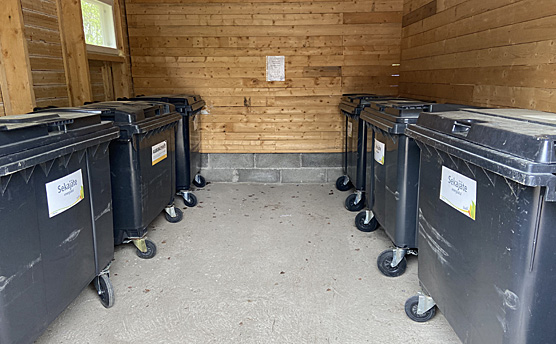Press release 2021-12-21 at 10:03

A waste collection point in Timanttikylät, Juuka. © Kati Pitkänen
"There is a persistent myth in Finland that sorting is not worthwhile because all the waste ends up in the same place. We decided to find out where the recyclable waste ends up from the households of the Timanttikylät villages in the small North Karelian municipality of Juuka," says Anne Holma, a Researcher at the Finnish Environment Institute.
The WasteLess Karelias project, funded by the Karelia CBC programme, revealed that all plastic, glass, cardboard and metal waste sorted in Juuka is treated either in Finland or abroad. Recycling produces valuable raw materials for new products and saves energy and natural resources.
Timanttikylät villages are exceptional rural villages as, in addition to energy waste, they separately collect packaging waste such as metal packaging and small metal waste, glass, cardboard, paper and plastic, at a collection point maintained by the village association. The costs of the recycling point are covered by voluntary work funds collected by the village association.
"In rural areas like Juuka, resident activity in waste sorting is especially important. Waste management arrangements often have to be agreed upon themselves or the sorted waste is taken to a waste centre or take-back points even over long distances. On the other hand, in rural areas, for example, home composting is used extensively for the treatment of biowaste," says Holma.
Where does recyclable waste end up from Juuka?
Plastics collected separately from Juuka, as well as from other parts of Finland, are mainly processed at the Riihimäki waste treatment plant. Recently, plastics have also been exported to Sweden and Germany, as Finland does not have enough capacity due to the rapid increase in plastic sorting. However, a new plant is planned to be built. Plastics are made into recycled raw materials or finished products, such as commercial recycled plastic bags and cleaning supplies.
Glass packaging passes through the Kuopio terminal to glass processing plants in Forssa and Estonia. There, the glass is processed and delivered as a raw material to glass packaging plants. Despite long transport distances, glass recycling is more environmentally friendly than making new glass, and glass can be recycled indefinitely.
Cardboard is transported to interim storage for baling, from where the bales are transported as raw material to the cardboard factory. Cardboard recycling plants are located in Varkaus and Pori, among other places. Recycled board is used to make corrugated board raw material, packaging board and packaging paper, saturating kraft paper and coreboard.
The metal packaging and small metal waste are delivered to a crushing plant in Tornio, after which the material is a smeltable raw material for the steel industry. The quality of the metal does not deteriorate during recycling, so it can be recycled indefinitely.
From waste to valuable resources
Waste should be seen as a valuable resource and its value will increase in the future. For example, the need for fertilisers increases as virgin natural resources dwindle. The Finnish company Tracegrow utilises the metals in used batteries as a raw material for fertilisers.
In Finland, the industry already uses metal, waste oils and paper imported from abroad. For example, electronic waste contains a lot of valuable metals, and the ways and possibilities to use them are still being explored.
"Waste ends up being recovered when it is sorted – even from a small village far away from big city centres like Timanttikylät villages in Juuka. Waste is a valuable raw material and recycling has many positive environmental impacts. Although transport journeys can be long and cause CO2 emissions, the use of waste as a raw material for new products is more environmentally beneficial than making them from natural resources and other primary raw materials," says Holma.
There are dozens of recycling plants in Finland. The market affects the place where different waste fractions should be treated. Biowaste, for example, is heavy and has high transport costs and it is therefore handled near the place of origin. If only small amounts of waste are generated, it is more cost-effective to transport them further away for centralised treatment. Hazardous waste is treated very centrally as this type of waste requires a particular facility.
Recycling needs to be further increased
The recycling rate of a municipal waste, waste generated by households and services, should reach 55 per cent in EU countries by 2025 and 65 per cent by 2035. The recycling rate of municipal waste in Finland stood at 42 per cent in 2020. Since there is still a long way to go, all the work to make recycling and sorting more efficient is important.
Household waste refers to municipal waste produced by homes, such as energy and biowaste, cardboard, paper, glass, metal and plastic waste. Household waste is taken to a waste container outside (mixed/energy waste) or to a local collection point, waste station or, when returning beverage bottles and cans, a reverse vending machine at a grocery shop.
Learn more
More information
- Researcher Anne Holma, Finnish Environment Institute, forename.surename@syke.fi, tel +358 295 251 180
The report is part of the WasteLess Karelias project which aims to improve sorting and waste management in rural villages in North Karelia and the Karelian Republic. The project encourages local residents, authorities and companies to improve their waste management system and the rural living environment. WasteLess Karelias builds waste collection points in rural villages and organises local waste management workshops, clean-up events, a cross-border school competition and a Trash-Art Festival. The project is lead by the University of Eastern Finland (UEF) and carried out in collaboration with three additional partners: Association for Rural Culture and Education (MSL), Institute of Economics of the Karelian Research Center (IoE) and the Finnish Environment Institute (SYKE).
Karelia CBC is a cross-border cooperation programme creating an attractive region for people and business. The programme is financed by the European Union, the Russian Federation and the Republic of Finland.